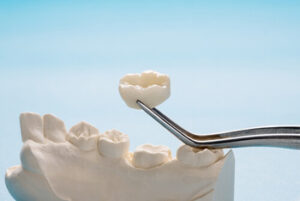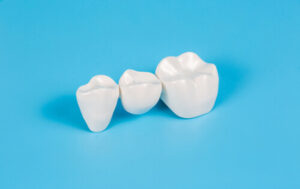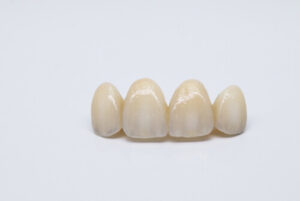When a tooth is damaged, decayed, or weakened, a dental crown can restore its strength, function, and appearance. Crowns are a popular dental restoration, offering both aesthetic appeal and durability. However, with various dental crown types available, choosing the right one depends on factors like material, cost, and longevity. This guide covers the various types of dental crowns and cost considerations, as well as their benefits, helping you make an informed choice for your oral health.
Why Would You Need a Dental Crown?
A dental crown is a custom-designed cap that encases a damaged or decayed tooth, restoring its strength, function, and natural look. While crowns are commonly used for tooth restorations, they also serve aesthetic purposes, especially when placed on front teeth.
You might need a dental crown procedure for several reasons, including:
1. Protecting a Weak or Damaged Tooth

2. Restoring a Broken or Worn-Down Tooth
Teeth can break due to injury, tooth decay, or wear and tear from grinding. A dental crown helps restore the tooth’s original shape and function.
3. Strengthening a Tooth After a Root Canal Therapy
After root canal therapy, a treated tooth is often fragile and prone to breakage. A permanent crown is placed over it to provide strength and longevity.
4. Supporting a Dental Bridge
A dental bridge fills the space left by missing teeth by securing artificial teeth to adjacent natural teeth or dental implants. These supporting teeth are fitted with dental crowns to hold the bridge in place securely.
5. Covering a Severely Discoloured or Misshapen Tooth
Some teeth are naturally misshapen or severely stained. A porcelain or ceramic crown can improve the aesthetic appeal by providing a natural tooth structure.
6. Replacing a Missing Tooth with a Dental Implant
A dental implant requires a custom crown to act as the visible replacement tooth. These crowns are usually made from zirconia crowns, ceramic, or porcelain fused to metal crowns for durability and aesthetics.
7. Protecting Children’s Teeth
In paediatric dentistry, stainless steel crowns are sometimes used for children with severely decayed baby teeth. These temporary crowns protect the tooth until it naturally falls out.
Since a dental crown treatment serves both restorative and cosmetic purposes, choosing the right dental crown material is important for maintaining oral health and achieving a healthy smile.
Exploring the Different Types of Dental Crowns
There are several dental crown types, each with unique properties. The best option depends on factors such as aesthetic appeal, durability, and cost.
1. Porcelain Crowns – A Natural and Aesthetic Choice
Porcelain crowns, also known as all-porcelain crowns, are widely used for front teeth restorations due to their ability to mimic the colour of natural teeth. These crowns offer an excellent natural appearance and are an ideal choice for those concerned with aesthetics.
Benefits:
- Closely resembles a natural tooth structure
- Does not contain metal, making it suitable for people with metal allergies
- Enhances the aesthetic appeal of front teeth
Drawbacks:
- Less durable than zirconia crowns or metal crowns.
- More vulnerable to chipping or cracking under excessive pressure.
Cost:
The cost of dental crowns made from porcelain typically starts at $1,500 per tooth.
2. Zirconia Crowns – A Strong and Aesthetic Option
Zirconia crowns are a perfect alternative to porcelain. They provide superior strength, durability, and natural appearance. This makes them a popular choice for back teeth restorations and dental implants.
Benefits:
- Highly resistant to chipping and cracking
- Can be colour-matched to natural teeth
- More durable than ceramic or porcelain crowns
Drawbacks:
- More expensive than some alternatives
- Requires additional tooth preparation due to its hardness
Cost:
A zirconia crown generally starts at $1,500 per tooth.
3. Metal Crowns – The Most Durable Choice
Metal crowns are fabricated from gold, platinum, or base metal alloys. These crowns are known for their long-lasting durability and are commonly used for back teeth that experience significant biting force.
Benefits:
- Extremely strong and long-lasting
- Requires minimal tooth preparation
- Does not chip or break easily
Drawbacks:
- Metallic colour is not ideal for front teeth restorations
- Gold crowns and other metals can be expensive
Cost:
- Gold crowns: starts at $2,000 per tooth
- Other metal crowns start at $1,200 per tooth
4. Porcelain-Fused-to-Metal Crowns – A Blend of Strength and Aesthetics
Porcelain fused to metal crowns (PFM) combine a metal base for durability with a porcelain exterior for a more natural look.

- Stronger than all-porcelain crowns
- Provides a natural tooth structure
- A good option for back teeth restorations
Drawbacks:
- Over time, the metal base may become visible at the gum line
- Can chip under high pressure
Cost:
The tooth crown cost for a PFM crown typically starts at $1,300 per tooth.
5. Ceramic or Porcelain Crowns – Metal-Free and Aesthetic
Similar to porcelain crowns, ceramic crowns are completely metal-free and offer an excellent natural appearance.
Benefits:
- Ideal for front teeth, where appearance matters most
- Safe for those with metal allergies
- Matches the shade of natural teeth
Drawbacks:
- Less durable than metal crowns
- More prone to fracture under heavy biting force
Cost:
A ceramic crown typically starts at $1,500 per tooth.
6. Stainless Steel Crowns – Temporary and Paediatric Use
Stainless steel crowns are commonly used as temporary crowns or for paediatric dental treatments to protect primary teeth.
Benefits:
- Affordable and durable
- Often used as temporary crowns before a final crown is placed
Drawbacks:
- Not suitable as a permanent crown for adults
- Not aesthetically pleasing
Cost:
A stainless steel crown cost starts at $250 per tooth.
7. Indirect Resin Crowns – Affordable and Temporary
Resin crowns are generally used as temporary crowns before a permanent crown is placed.
Benefits:
- Less expensive than other dental crown types
- Quick to fabricate
Drawbacks:
- Less durable than other materials
- Wears down quickly
Cost:
A resin crown costs start at $300 per tooth.
Factors Affecting the Cost of Dental Crowns
The cost of dental crowns is influenced by multiple factors, including:
- The dental crown material used
- Location and dental practice fees
- Dental lab fees for making custom crowns
- Additional dental procedures (e.g., root canal therapy, dental implant)
- Dental insurance coverage
How Long Do Dental Crowns Last?
The lifespan of a dental crown is determined by the material used and the level of oral care maintained:
- Porcelain or ceramic crowns: 10-15 years
- Zirconia crowns: 15-20 years
- Metal or gold crowns: 20+ years
- PFM crowns: 10-15 years
Good oral health habits and regular dental check-ups can extend the lifespan of your dental restoration.
Step-by-Step Guide to Getting a Dental Crown: What to Expect
If you need a dental crown, understanding the dental crown procedure can help ease any concerns and prepare you for the process. The procedure typically requires two dental visits, unless you opt for same-day crowns made with advanced dental laboratory technology.
Here is a step-by-step breakdown of what happens when you get a tooth crown:
Step 1: Consultation and Examination
Your dental practice will begin by evaluating your dental health. This includes:
- Examining the damaged tooth to determine if a dental crown is necessary
- Performing X-rays to evaluate the tooth’s roots and the surrounding bone.
- Discussing the best dental crown material based on your needs, such as porcelain crowns, zirconia crowns, or metal crowns
If a tooth is seriously decayed or infected, root canal therapy may be necessary before a crown can be placed.
Step 2: Tooth Preparation
Before placing a final crown, the affected tooth must be prepared. This step involves:
- Numbing the area with local anaesthesia for comfort
- Shaping the tooth by removing a thin layer of natural tooth structure to make room for the crown
- Filling in any decayed or broken areas with a dental restoration
If the tooth is too damaged, a dental crown treatment may involve building up the tooth with dental cement before shaping it.
Step 3: Taking Dental Impressions
After shaping, the dentist will take a precise impression of the prepared tooth. This ensures that your custom crown fits perfectly. The impressions are then delivered to a dental laboratory, where skilled technicians craft the crown to match your natural teeth.
If you are getting porcelain or ceramic crowns, the colour will be matched to your existing teeth for a seamless blend.
Step 4: Placing a Temporary Crown
Since it takes one to two weeks for the dental lab to create a customised crown, a temporary crown is utilised to:
- Protect the prepared tooth from sensitivity
- Maintain oral health by preventing shifting of surrounding teeth
- Enable you to eat and speak comfortably until the permanent crown is placed
Temporary crowns are usually made from resin crowns or stainless steel crowns, which are not as durable as the final crown.
Step 5: Final Crown Placement
After your dental crown is prepared, you will visit your dentist for a follow-up appointment, where the permanent crown is placed. The steps include:
- Removing the temporary crown
- Checking the fit, colour, and bite alignment of the new crown
- Making minor adjustments if necessary
- Cementing the crown in place using strong dental cement
Following the dental procedure, your new crown will integrate naturally with your existing teeth, improving both function and appearance.
Step 6: Recovery and Aftercare
It may take a few days to adjust to your dental crown, especially if it is on a back tooth. Some aftercare tips include:
- Avoiding hard or sticky foods for the first few days
- Sticking to good oral hygiene habits by brushing and flossing daily
- Attending regular dental check-ups to ensure the dental crown remains in good condition
With proper care, a tooth crown can last 10 to 20 years, depending on the dental crown material used.
Dental Crown vs. Other Restorative Treatments: Which One is Right for You?
Several treatment options are available when restoring damaged, decayed, or missing teeth. Dental crowns are a popular choice, but they are not the only solution. Here’s how dental crowns compare to other common restorative treatments.
Dental Crowns vs. Veneers – Which is Better for Front Teeth Restorations?
Both dental crowns and veneers enhance the aesthetic appeal of teeth, but they serve different purposes. Veneers are ultra-thin shells designed to cover only the front surface of a tooth, making them ideal for minor cosmetic improvements like discolouration, chips, or slight misalignment. In comparison, dental crowns encase the entire tooth, offering both aesthetic improvement and structural support.
A dental crown is the better choice if the tooth is severely damaged, weakened, or decayed, as it restores both function and appearance. However, if the concern is purely cosmetic and the tooth is otherwise healthy, veneers are a more conservative option, requiring less removal of natural tooth structure.
Dental Crowns vs. Fillings – When is a Crown Necessary?
Fillings aim to restore teeth with minor to moderate cavities, while dental crowns are necessary for teeth with extensive decay or structural damage. A filling is placed inside the cavity and works well for small areas of decay. However, if a tooth has a large cavity, is fractured, or has undergone root canal therapy, it may be too weak to support a filling alone.
A dental crown covers the whole tooth, preventing further decay and reinforcing its structure. If a tooth is at risk of breaking or has already lost a significant portion of its natural tooth structure, a crown is a more effective and long-lasting solution.
What to Expect After Getting a Dental Crown
A dental crown restores the strength and appearance of a damaged tooth, but adjusting to it takes time. Knowing what to expect post-treatment can help ensure a smooth recovery and long-lasting results.
Immediate Aftercare Instructions
After a dental crown procedure, it is normal to experience mild sensitivity or discomfort. Your dentist may recommend waiting until the anaesthesia wears off before eating to prevent accidentally biting your cheek or tongue. If you have a temporary crown, you should be especially careful when chewing, as temporary crowns are not as strong as the final ones.
Over-the-counter painkillers can help manage any mild discomfort. If you experience persistent pain, swelling, or an uneven bite, you should consult your dental practice immediately.
Adjusting to the Feel of a New Crown
A new dental crown may feel slightly different at first. Some patients experience minor sensitivity to hot or cold foods, especially if the tooth was treated for decay or root canal therapy. The bite may also feel unusual for the first few days, but this usually resolves as the mouth adjusts.
If discomfort continues or the bite feels significantly off, your dentist can make minor adjustments to ensure proper alignment.
Foods to Avoid in the First Few Days
To prevent damage or dislodging, certain foods should be avoided, especially while wearing a temporary crown. These include:
- Sticky foods like caramel or gum, which can pull the crown off
- Hard foods like nuts, ice, or popcorn kernels, which may crack the crown
- Very hot or cold foods that may trigger sensitivity
After the permanent crown is firmly in place, you can slowly resume your normal diet, though it’s best to avoid biting into hard foods with the crowned tooth.
How Long Does It Take to Fully Heal?
Most patients adjust to their dental crowns within a few days. The gum tissue around the tooth may take up to two weeks to heal completely, especially if any inflammation occurs during the tooth preparation process.
While healing is usually quick, maintaining good oral hygiene is crucial to prevent complications such as tooth decay under the crown.
How to Extend the Life of Your Dental Crown: The Importance of Regular Dental Check-Ups

Best Oral Hygiene Practices for Maintaining Crowns
- Brush twice daily with fluoride toothpaste to prevent decay in surrounding teeth
- Floss daily, especially around the crown, to remove food particles
- Use a non-abrasive toothpaste to prevent scratching ceramic crowns
Final Thoughts
Choosing the right dental crown type depends on factors such as function, aesthetics, and cost. Whether you need front teeth restorations, back teeth restorations, or a dental implant restoration, there is a suitable option for everyone.
If you are considering a dental crown treatment, book a consultation with Dental 266 at 02 9051 0600 to discuss the best option for your healthy smile. Always remember, regular dental check-ups and proper care will help your final crown last for many years.
Note: Any surgical or invasive procedure carries risks. Before proceeding, you should seek a second opinion from an appropriately qualified health practitioner.
References
- Medical News Today. (n.d.). What to know about temporary crowns. Retrieved from https://www.medicalnewstoday.com/articles/temporary-crown
- Colgate. (n.d.). What is good oral hygiene? Retrieved from https://www.colgate.com/en-us/oral-health/adult-oral-care/what-is-good-oral-hygiene
- WebMD. (n.d.). Veneers: What you need to know. Retrieved from https://www.webmd.com/oral-health/veneers
- Cleveland Clinic. (n.d.). Dental impressions. Retrieved from https://my.clevelandclinic.org/health/diagnostics/22671-dental-impressions
- Healthline. (n.d.). Dental anesthesia: What you need to know. Retrieved from https://www.healthline.com/health/dental-and-oral-health/dental-anesthesia
- American Association of Endodontists. (n.d.). What is a root canal? Retrieved from https://www.aae.org/patients/root-canal-treatment/what-is-a-root-canal/






